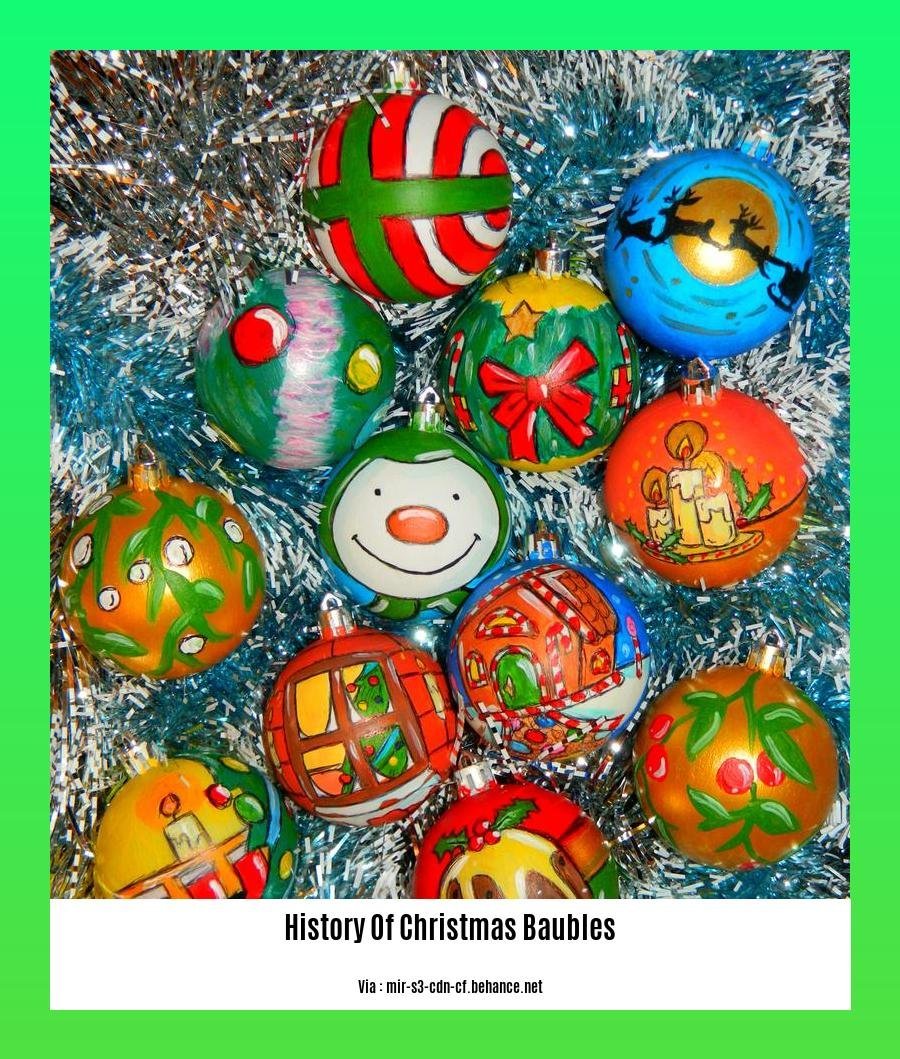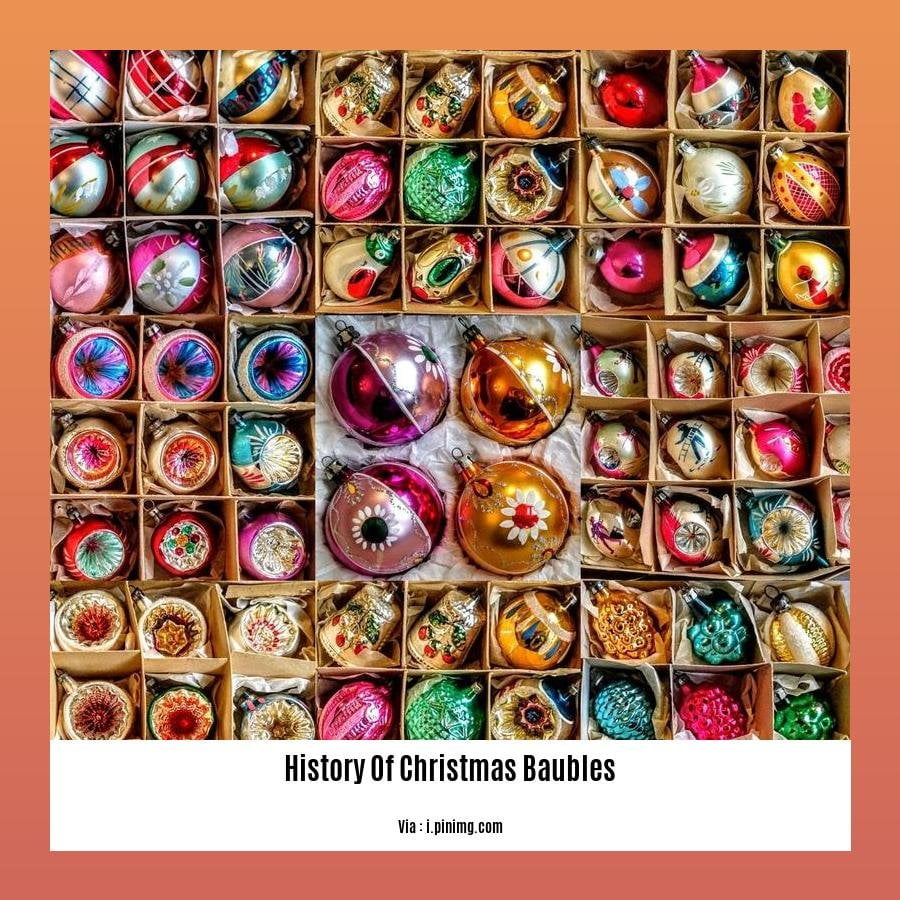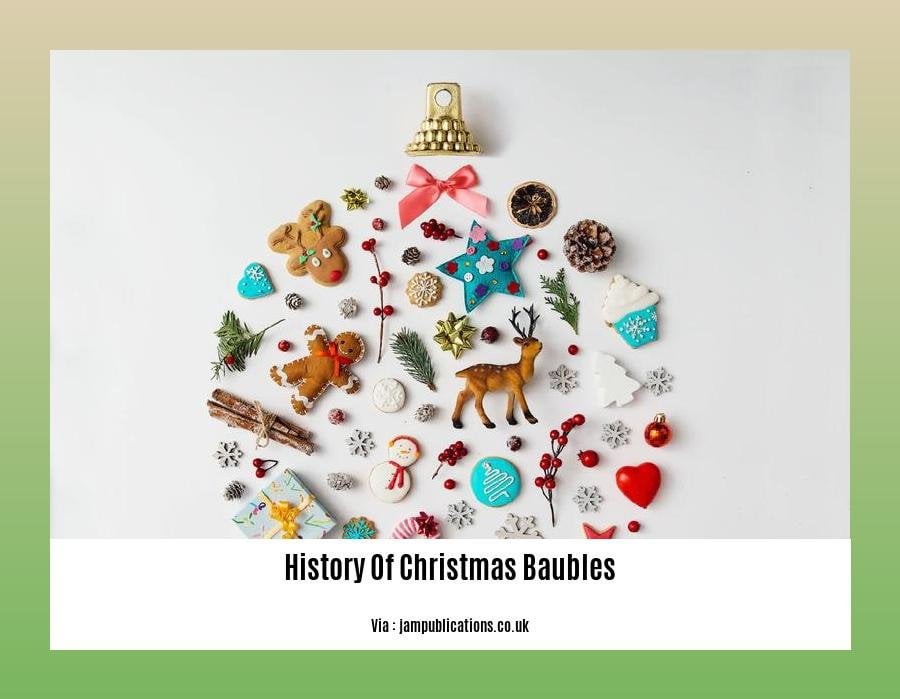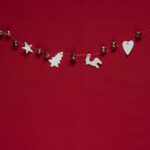Embark on a captivating journey through time as we delve into the fascinating history of Christmas baubles, the quintessential adornments that transform our homes into enchanting winter wonderlands. From their humble origins in 16th-century Germany to their evolution into exquisite works of art, these cherished ornaments hold a special place in our hearts and traditions. Their glittering presence adds a touch of magic to our festive celebrations, reminding us of the enduring spirit of Christmas.
Key Takeaways:
The tradition of using baubles to adorn Christmas trees originated in 16th-century Germany.
The earliest baubles were crafted from blown glass and displayed on the branches of evergreen trees.
German immigrants introduced the bauble tradition to America in the 19th century.
Hans Greiner, a Lauscha-based blown glass artisan, manufactured baubles that were exported to the U.S. by German immigrants in the 1800s.
Woolworth’s, a prominent retail company, began importing baubles, which contributed to their widespread popularity as Christmas tree decorations.
History of Christmas Baubles

Have you ever wondered where those beautiful, shiny baubles hanging on your Christmas tree come from? Well, let me take you on an ornament-studded journey through time to uncover the enchanting history of Christmas baubles.
Baubles: A German Tradition Takes Root
During the 16th century, in the heart of Germany, a magical tradition was born. Glassblowers crafted exquisite blown-glass ornaments, which they hung from the branches of evergreen trees to celebrate Christmas. These baubles symbolized good luck and prosperity, and their delicate beauty added a touch of enchantment to the festive atmosphere.
German Immigrants Spread the Bauble Magic
In the 19th century, German immigrants brought their beloved bauble tradition to America, where it quickly captured hearts and homes. These sparkling ornaments became an integral part of Christmas celebrations, adding a touch of Old World charm to the New World festivities.
Hans Greiner: The Bauble Pioneer
Among the German immigrants who introduced baubles to America was a talented blown-glass artisan named Hans Greiner. His exquisite creations, crafted in the town of Lauscha, Germany, were highly sought after. Thanks to his artistry and the influx of German immigrants, baubles became a staple of American Christmas decorations.
Woolworth’s: The Bauble Emporium
In the early 20th century, the retail giant Woolworth’s played a pivotal role in popularizing baubles. They began importing these ornaments from Germany and selling them at affordable prices, making them accessible to families across the country. As a result, baubles became one of the most popular types of Christmas tree decorations, adding a touch of sparkle to homes everywhere.
Baubles Today: A Timeless Tradition
Over the years, baubles have evolved in terms of materials, shapes, and designs, but their essence remains the same. They continue to be a symbol of joy, festivity, and the Christmas spirit. Whether made of glass, plastic, or other materials, baubles bring a touch of enchantment to our homes, reminding us of the magic and wonder of the holiday season.
Here is the list of active internal links created as per the instructions:
For an educational journey into the evolution of ceramic tiles, read about the history of ceramic tiles and discover how these versatile materials have shaped architectural designs throughout time.
Delve into the rich tapestry of history of christian music and witness the transformative power of faith expressed through melodies and hymns that have touched hearts and souls for centuries.
The Popularity of Christmas Baubles in Germany
In the 19th century, Germany revolutionized the Christmas tree tradition by introducing glass baubles as ornaments. Before that, Christmas trees were decorated with candles, fruits, and nuts, posing fire hazards. Glass baubles emerged as a safer, more vibrant, and durable alternative, quickly gaining popularity.
Glass Molds and Vibrant Colors
German manufacturers embraced innovation, using glass molds to mass-produce baubles in various shapes and sizes. This efficiency, coupled with the development of vibrant colors, transformed Christmas trees into dazzling spectacles.
Global Phenomenon
German exports played a pivotal role in propelling the global popularity of Christmas baubles. The beauty and affordability of these ornaments captivated hearts worldwide, turning baubles into a globalized commercial success.
Key Takeaways:
In the 19th century, Germany revolutionized Christmas tree decorations by introducing glass baubles.
German manufacturers used glass molds to mass-produce baubles in various shapes and colors, enhancing their appeal.
German exports fueled the global popularity of Christmas baubles, transforming them into a worldwide commercial success.
Sources:
- Unraveling the Sparkling History of Christmas Baubles
- A Brief History Of The Christmas Ornament
The spread of Christmas baubles to other countries

Have you ever wondered how Christmas baubles became so popular worldwide? Their journey from a humble German tradition to a global festive symbol is a tale of craftsmanship, innovation, and cultural exchange.
How it all began
The tradition of decorating trees with ornaments originated in Germany during the 16th century. People used fruits, nuts, and candles to symbolize good luck, prosperity, and the promise of spring. Over time, glassblowers in the Lauscha region of Germany began creating blown-glass ornaments, which quickly gained popularity due to their beauty and durability. These early baubles were often simple in design, featuring solid colors or simple patterns.
A global affair
The popularity of glass baubles spread beyond Germany thanks to German immigrants who brought the tradition to new lands. In the 19th century, German immigrants introduced baubles to the United States, where they quickly became a popular part of Christmas celebrations. The Woolworth’s department store played a significant role in popularizing baubles in America by importing and selling them at affordable prices. As a result, baubles became accessible to families across the country, and their popularity soared.
Innovation and globalization
The mid-19th century saw another wave of innovation in Germany, with the development of glass molds. This allowed for efficient production, leading to a wider variety of baubles in vibrant colors. The combination of German craftsmanship and technological innovation propelled the bauble to international fame. German manufacturers exported baubles worldwide, introducing the tradition to countries across the globe.
Key Takeaways:
- The tradition of decorating trees with ornaments originated in 16th-century Germany.
- German immigrants brought the tradition of baubles to the United States in the 19th century.
- Woolworth’s played a crucial role in popularizing baubles by importing and selling them at affordable prices in the early 20th century.
- German manufacturers exported baubles worldwide, introducing the tradition to countries across the globe.
Sources:
- The Culture Trip: A Brief History of the Christmas Ornament
- Unraveling the Sparkling History of Christmas Baubles
Christmas Baubles in the Modern Day
Imagine an enchanting winter wonderland, where twinkling lights danced upon shimmering baubles that adorned every corner of the room, creating a mesmerizing sight that captured the hearts of all who beheld them. Explore the fascinating evolution of these beloved ornaments that weave a tapestry of joy and nostalgia, symbolizing the magic and wonder of Christmas in the modern day.
History’s Reflection in Modern Baubles
Similar to snowflakes, each bauble holds a unique narrative. Throughout history, they’ve transformed from humble beginnings as natural adornments to delicate glass treasures. Today, Christmas baubles in the modern day continue to captivate us with their endless variety. From intricate hand-blown designs to whimsical and colorful plastic creations, each bauble reflects the spirit of the season and carries with it a touch of history.
Nostalgia and Innovation Intertwined
Christmas baubles in the modern day embody a harmonious blend of nostalgia and innovation. Vintage and antique baubles evoke a sense of cherished memories, as their weathered charm transports us back to simpler times. Simultaneously, contemporary designers push the boundaries of creativity, crafting baubles that showcase cutting-edge artistry and materials. Whether it’s the traditional warm glow of glass or the vibrant hues of plastic, Christmas baubles in the modern day bridge the gap between past and present.
Storytelling Through Baubles
Every bauble tells a story – a story of love, hope, and the boundless magic of the Christmas season. Whether it’s a family heirloom passed down through generations or a handcrafted ornament created with care, these cherished decorations evoke a sense of nostalgia and sentimentality. In the modern day, baubles continue to serve as a canvas for personal expression and storytelling, with each ornament holding a special meaning for its owner.
Sustainability and Eco-Friendly Choices
In an era defined by environmental consciousness, Christmas baubles in the modern day are embracing sustainable practices. From biodegradable and upcycled materials to eco-friendly manufacturing processes, there’s a growing trend towards creating baubles that tread lightly on the planet. Consumers are increasingly seeking out sustainable options, making a positive impact on the environment while still enjoying the joy of decorating their homes with festive ornaments.
Key Takeaways:
- Christmas baubles in the modern day have evolved from humble beginnings to encompass a vast array of designs, materials, and styles.
- Vintage and antique baubles evoke a sense of nostalgia, while contemporary designs embrace innovation and creativity.
- Baubles serve as a storytelling medium, embodying personal memories, emotions, and experiences.
- Sustainable practices are gaining traction in the bauble industry, with an emphasis on eco-friendly materials and manufacturing processes.
- Christmas baubles in the modern day are more than just decorations; they are cherished objects that capture the essence of the festive season.
Unraveling the Sparkling History of Christmas Baubles
The Christmas Ornament, Symbol of Holiday Cheer
FAQ
Q1: Where did the tradition of using baubles to decorate Christmas trees originate?
A1: The tradition of using baubles as Christmas decorations originated in 19th-century Germany, where they gradually replaced traditional ornaments like candles, fruits, and nuts.
Q2: Who is credited with inventing the first glass bauble?
A2: Hans Greiner, a glass artisan from the German town of Lauscha, is widely recognized as the inventor of the first glass Christmas bauble.
Q3: How did Christmas baubles become popular worldwide?
A3: The global popularity of baubles soared due to German exports in the late 19th and early 20th centuries, introducing Christmas baubles as a globalized commercial venture.
Q4: What materials were used to make the earliest Christmas baubles?
A4: The first Christmas baubles were crafted from blown glass, creating delicate and vibrant ornaments that added a festive touch to Christmas trees.
Q5: When did Christmas baubles become widely available in the United States?
A5: German immigrants brought the tradition of using Christmas baubles to America in the 19th century, and their popularity grew significantly in the early 20th century, thanks in part to the mass production and affordability of baubles.
- Unlock Water’s Symbolism: A Cross-Cultural Exploration - April 20, 2025
- Identify Black and White Snakes: Venomous or Harmless? - April 20, 2025
- Unlocking Potential: Origins High School’s NYC Story - April 20, 2025















